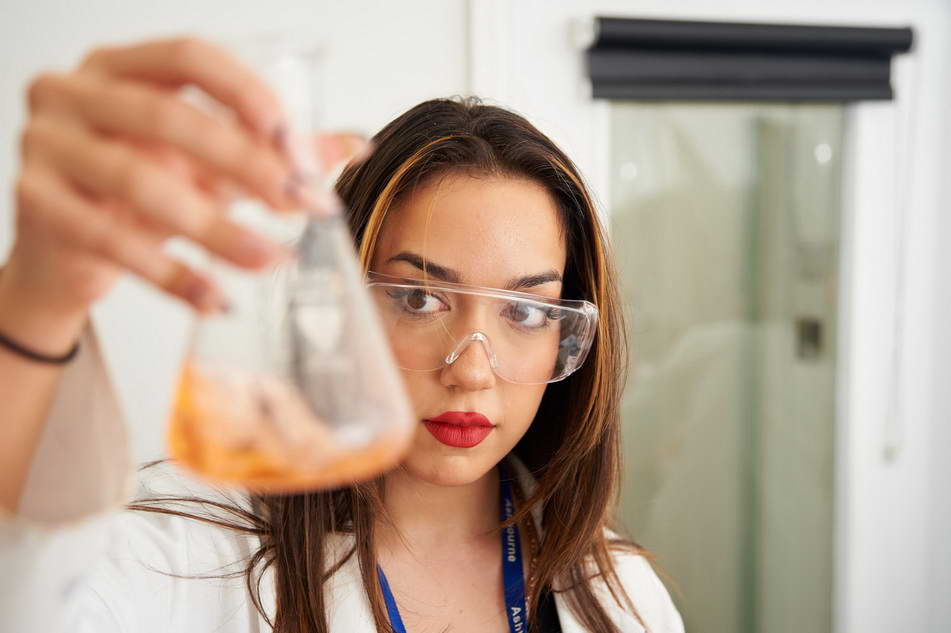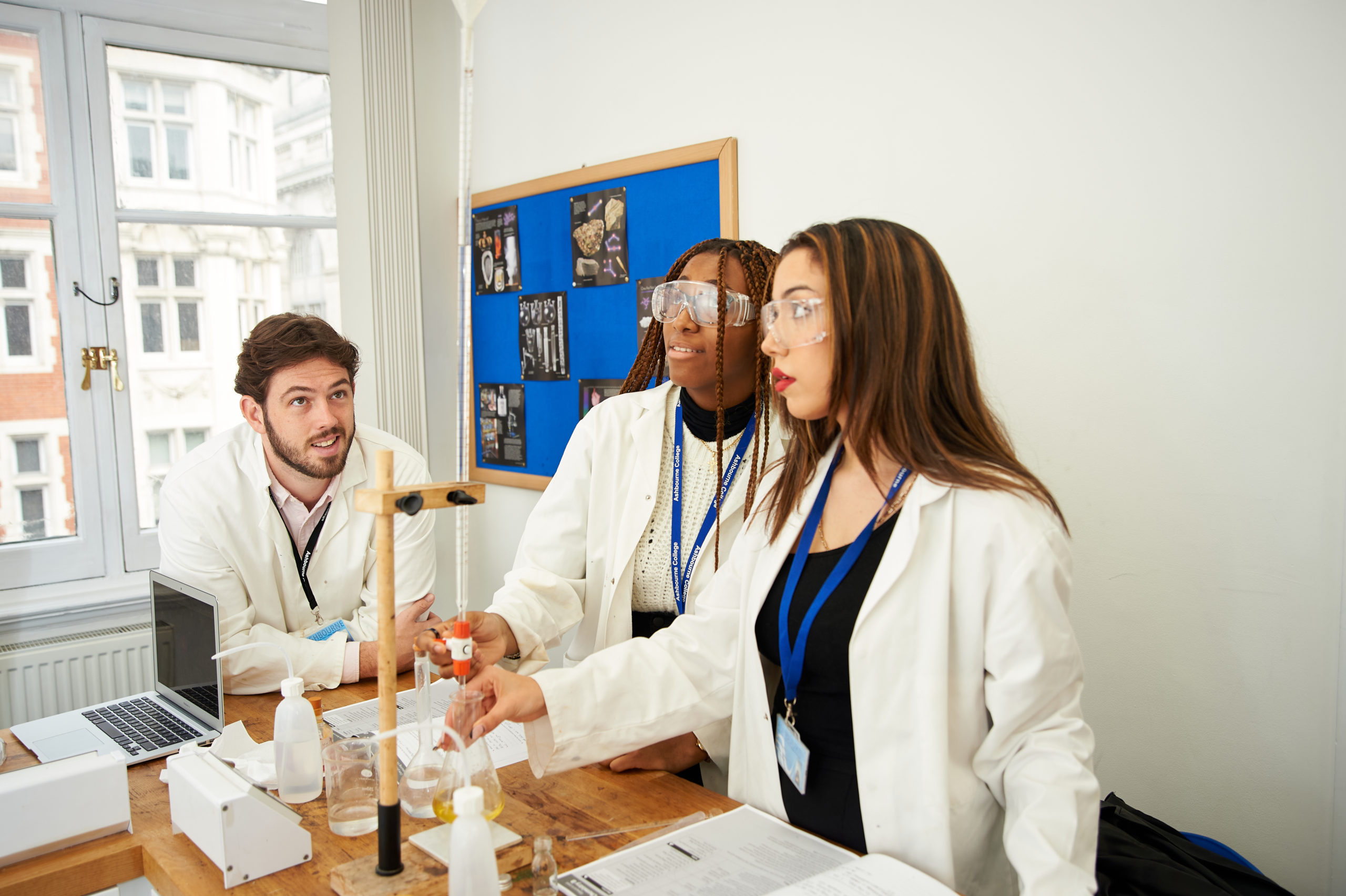Ashbourne follows the Edexcel specification for Chemistry A level and AS level.
This course covers nineteen topics relating to inorganic, organic and physical chemistry. In very simplistic terms inorganic chemistry examines the characteristics of the elements, except carbon, and their compounds; organic chemistry explores the chemical reactions in living organisms and what can be derived from them, for example petrochemicals, shampoos, paper, drugs, synthetic fibres; and physical chemistry works at a molecular and atomic level and investigates how chemical reactions occur.
Within these three areas – inorganic, organic and physical chemistry – AS level students cover topics 1–10 and A level students cover all topics listed in the tables below. A level students will sit a third exam paper General and Practical Principles in Chemistry, also described in the table below.
There will also be a series of internally assessed practicals throughout the course to help students develop and demonstrate their understanding and competence.
AS level Chemistry
Core Inorganic and Physical Chemistry
Topic 1: Atomic Structure and the Periodic Table
Topic 2: Bonding and Structure
Topic 3: Redox I
Topic 4: Inorganic Chemistry and the Periodic Table
Topic 5: Formulae, Equations and Amounts of Substance
AS level written exam: 1 hr 30, 80 marks, 30% of overall result.
The paper may include multiple-choice, short open, open-response, calculations and extended writing questions.
Organic and Physical Chemistry
Topic 2: Bonding and Structure
Topic 5: Formulae, Equations and Amounts of Substance
Topic 6: Organic Chemistry I
Topic 7: Modern Analytical Techniques I
Topic 8: Energetics I
Topic 9: Kinetics I
Topic 10: Equilibrium I
AS level written exam: 1 hr 30, 80 marks, 30% of overall result.
The paper may include multiple-choice, short open, open-response, calculations and extended writing questions.
A level Chemistry
Topic 1: Atomic Structure and the Periodic Table
Topic 2: Bonding and Structure
Topic 3: Redox I
Topic 4: Inorganic Chemistry and the Periodic Table
Topic 5: Formulae, Equations and Amounts of Substance
Topic 8: Energetics I
Topic 10: Equilibrium I
Topic 11: Equilibrium II
Topic 12: Acid-base Equilibria
Topic 13: Energetics II
Topic 14: Redox II
Topic 15: Transition Metals
A level written exam: 1 hr 45 mins, 90 marks, 30% of overall result.
The paper may include multiple-choice, short open, open-response, calculations and extended writing questions.
Topic 2: Bonding and Structure
Topic 3: Redox I
Topic 5: Formulae, Equations and Amounts of Substance
Topic 6: Organic Chemistry I
Topic 7: Modern Analytical Techniques I
Topic 9: Kinetics I
Topic 16: Kinetics II
Topic 17: Organic Chemistry II
Topic 18: Organic Chemistry III
Topic 19: Modern Analytical Techniques II
A level written exam: 1 hr 45 mins, 90 marks, 30% of overall result.
The paper may include multiple-choice, short open, open-response, calculations and extended writing questions.
Practicals
There are a least 16 core practicals that students must plan and conduct to investigate things such as how certain elements react with water, heating nitrates or carbonates; how flame colours of s-block elements such as potassium, magnesium and sodium differ; how to prepare iodine from seaweed; how to extract limonene from orange peel; how to set up electrochemical cells; and how to use chromotography (separating components) to identify metals in a ‘silver’ coin or amino acids in a protein. From these practicals students will learn to accurately collect data, analyse and interpret their findings, extrapolate ideas and identify areas for further enquiry.
During these practicals students will also need to think about ethical issues such as sustainability of resources (deciding how much ‘rare’ material to use in an experiment), safe waste disposal (finding a better place than down the sink to pour toxic compounds) and safety in the lab (avoiding accidental fumigation).
Students will be examined on all aspects of the practicals they have conducted, as described above, and also asked to apply what they have learned to other practical scenarios. This includes analysing outcomes, drawing valid conclusions and considering methods and data.
A level written exam: 2 hrs 30 mins, 120 marks, 40% of overall result.
The paper may include multiple-choice, short open, open-response, calculations and extended writing questions. Some questions will assess conceptual and theoretical understanding of experimental methods.
Ketevan Nizharadze
MEd Transforming Practice; PGCE (Cambridge); BSc Biomedicine with Data Sciences (Surrey)
Ketevan has a background in bioengineering research and has taught Chemistry to a wide range of year groups in the private education sector. She loves helping students tackle the puzzle-like challenges of chemistry, from tricky mole calculations to complex energetics.
By running the Chemistry Olympiad club and other Chemistry competitions, she offers students opportunities to stretch their curiosity and enjoy problem-solving beyond the syllabus.
Paddy O’Driscoll
BSc Analytical Chemistry with Quality Assurance (Munster Technological University); PGCE Secondary Education – Chemistry (Bishop Grosseteste University)
Paddy is dedicated to unlocking student potential and inspiring a love of learning. He sets an excellent example with a first-class honours in Chemistry and prestigious awards for academic excellence. His industry experience as a QCL analyst at a multinational pharmaceutical company enables him to bring real-world applications to the classroom, making lessons engaging and relevant.
Virash Patel
BSc (Hons) (CSci), CChem (FRSC)
Virash has been teaching at Ashbourne for many years. Before joining the college he held the roles of Director of Studies and Head of Chemistry, as well as teaching Biology and Chemistry. In addition to his teaching roles, Virash has worked as an analytical chemist in industry, and was awarded a fellowship from the Royal Society of Chemistry. Virash helps prepare students for entry onto medicine related courses, as well as Oxbridge and offers instruction and guidance to students in their UCAS applications.
Chris Todd
BSc Hons Chemical Sciences (East Anglia); PGCE Chemistry (Roehampton); HoD Biology
Chris has been teaching Chemistry at Ashbourne for many years and is a widely respected by his students. He was a research chemist in the field of semi conductors, then an investment banker prior to teaching.
Edexcel AS/A level Chemistry
Curtis, Scott and Murgatroyd
Edexcel A level Chemistry book 2
Curtis, Scott and Murgatroyd
Books
The Canon – The Beautiful Basics of Science by Natalie Angier
Erudite and amusing guide to becoming science literate. From stem cell research to global warming, writer and New York Times science journalist Natalie Angier draws on her enlightening conversations with many of the world’s leading scientists and brings science to the masses.
A Short History of Nearly Everything by Bill Bryson
Award winning writer Bill Bryson takes us on a rollocking journey from the Big Bang to civilisation as we know it in his quest to find out everything! Barely a scientific stone is left unturned on his travels through space and time as he offers his entertaining view of the world.
Uncle Tungsten: Memories of a Chemical Boyhood by Oliver Sachs
A witty and wonderful personal journey of a lifetime of scientific discovery and enlightenment.
The Periodic Table by Primo Levi
Primo Levi’s collection of short stories draws philosophical parallels from chemistry with his own personal experience of atrocity in Fascist Italy and Auschwitz. The Royal Institution named this modern classic as ‘the best science book ever written’.
Print and online
New Scientist
Online and print publication about all things science related.
Phys.org
Web-based news provider covering a wide range of science, research and technology topics.
Organisations
The Royal Institution
The Royal Institution has been at the heart of scientific research and education from more than two hundred years. Ten elements on the periodic table where discovered at the Institution by scientists such as Humphry Davy, William Ramsay and William Crookes.
The Institution runs a wide range of science courses for all levels. It also produces the popular UK flagship science series called the Christmas Lectures, originally founded by Michael Faraday, which is broadcast annually and includes topics like how to survive in space, life fantastic, growing up in the universe and the language of animals.
The Royal Society
This is one of the oldest scientific academies in the world. It runs a variety of programmes to highlight and support science in education, industry, international partnership and government. It also publishes a wide range of science journals.
Royal Society of Chemistry
This long-established organisation brings together chemical scientist from around the world. It is a professional body that supports and represents its members. It also publishes a wide range of journals and books.


